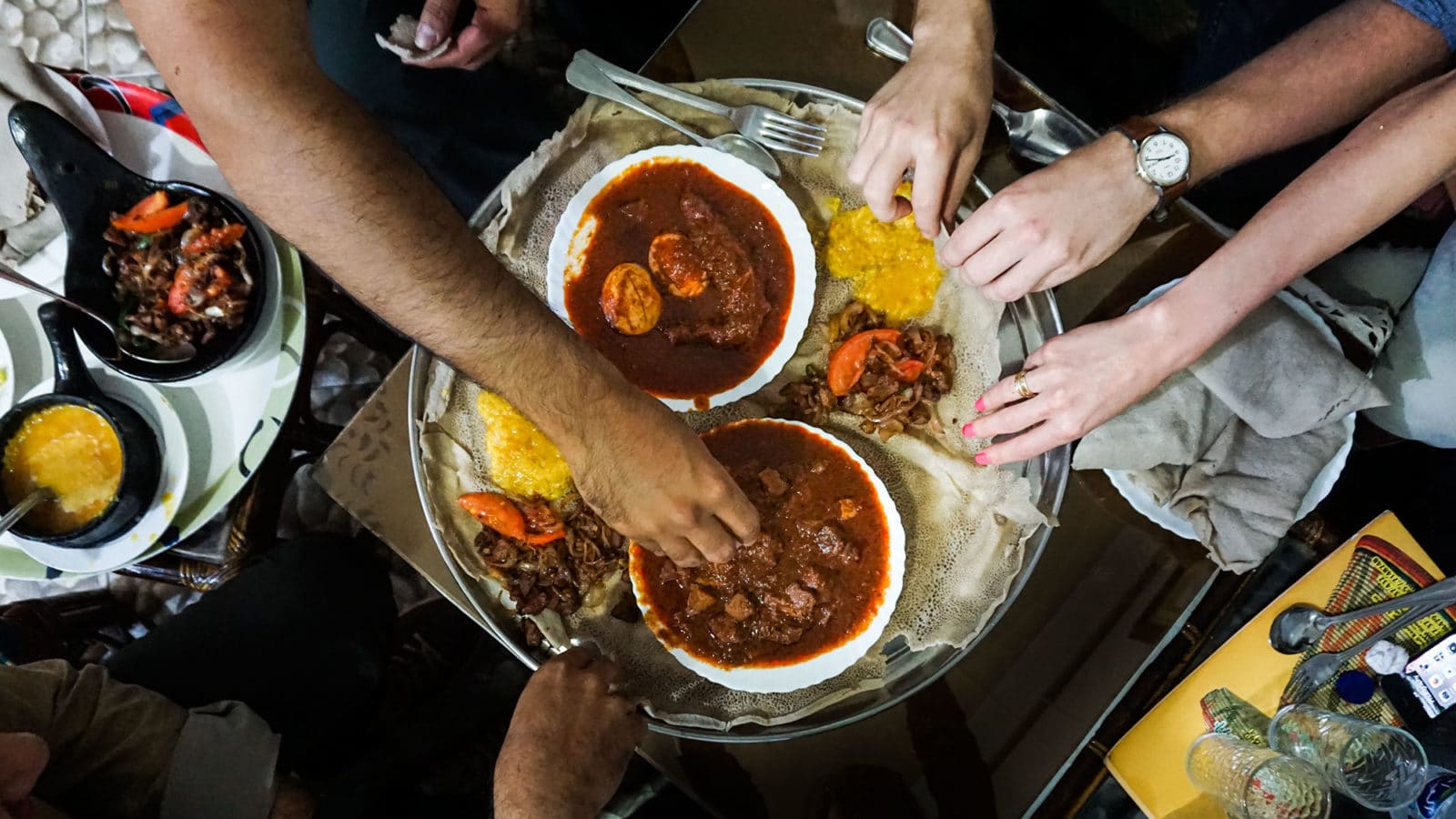6 restaurants in Dubai that serve traditional meals you can enjoy with your hands
There’s no dearth of restaurants in Dubai serving traditional meals that can be enjoyed with your hands. The city is home to many cultures that traditionally eat some or all their meals with their hands: Indian, Filipino, Jordanian, Yemeni, Ethiopian, Sudanese and of course, the native Emirati to name a few. At Frying Pan Adventures, we’re die-hard advocates of eating with our hands wherever possible! We’ve even hosted a limited edition food tour called “No Cutlery Please!” across restaurants in Dubai serving meals that lend themselves to digging right in with hands.
Tune in to our podcast (or read the transcript) to learn about the quirks and perks of eating with hands across four of these many cultures found in Dubai—Indian, Jordanian, Filipino and Ethiopian—with our Frying Pan Adventures’ food tour guides, Farida Ahmed and Nahla Tabbaa.
And read on to get a list of our favourite restaurants in Dubai Nahla Tabbaathat serve meals you can scoop up with your fingers!
Want more of our scrumptious podcast episodes? Feast on our main podcast page here!
Subscribe on: Apple Podcast App | Spotify (available on AppStore and Google Play) | Google Play Music (currently supported only for listeners in US/Canada) | Anghami
1. INDIAN THAALI AT MAHARAJA BHOG
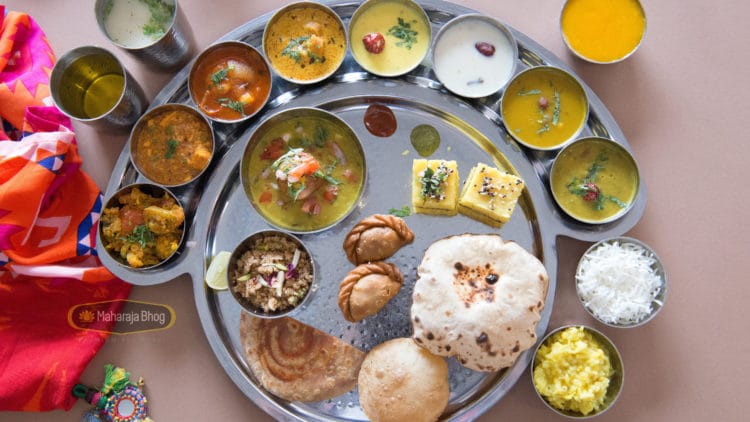
Maharaja Bhog in Ansar Gallery in Karama is a vegetarian feast for the senses—and we’d challenge carnivores to walk away hungry! They serve an all-you-can-eat Gujarati thaali where your thaali, or steel plate and bowls, are constantly refilled with a host of snacks, pickles, breads, rice, lentils, vegetables and sweets by servers whose mission is to feed you until you burst. We love dipping our rotis into all the different little bowls of vegetables and lentils and reserve the spoon only for the runny kichdi (delicious rice and lentil dish) and sweets. Tune in to our podcast (or read the transcript) to learn about what Ayurveda claims are the benefits of eating with your hands!
2. RICE & PARIPPU ON A BANANA LEAF AT AARAMAM
Aaramam in Karama is one of the city’s best kept secrets by the Indian Keralite community. Their beef fry (ularthiyathu) and layered parotta bring us back to this little gem over and over again. But the real charm is in visiting the restaurant during the peaceful lunch hour rather than the dinner rush. They serve lunch over a banana leaf and you can practice the challenging art of scooping up rice and parippu (lentils) with your fingers. Get some tips on how to make the perfect bite on our podcast (or read the transcript).
PS. We forbid you to leave Aaramam without tasting their complimentary pickles.
3. JORDANIAN MANSAF FROM QWAIDER AL NABULSI
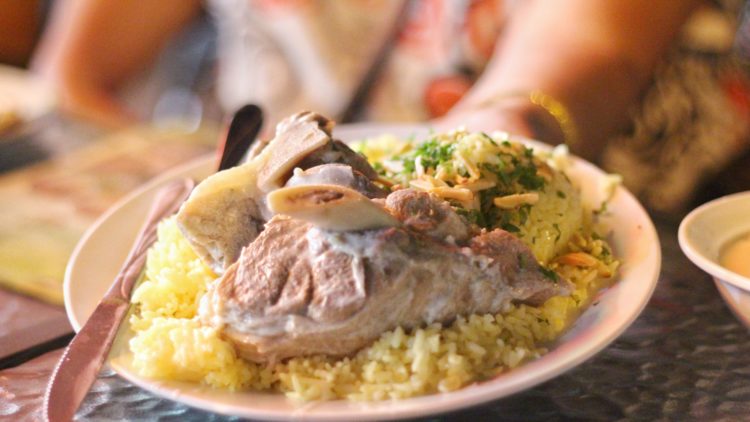
Jordanian mansaf is a dish of buttery rice and tender lamb that’s been slow cooked in preserved yogurt or jameed. The traditional way of eating this dish is in massive communal platters and extra jameed sauce is spooned over the meat like a wonderfully creamy gravy (Learn more about this tradition our podcast or read the transcript). Diners stand around the platter with their left hands behind their backs and their right hands being used to scoop up rice and meat, mould it into balls and then flip the wet morsel into their mouths! As our food tour guide Nahla shared on the podcast, mansaf is best enjoyed at home rather than at the restaurant. So if you plan to gather close family and friends for a mansaf feast, order in a platter from Qwaider Al Nabulsi in Deira. They also serve individual mansaf portions and the large platters at the restaurant itself, should you feel ready to showcase your mansaf eating skills to the broader public.
4. FILIPINO BOODLE FIGHT AT DAMPA SEAFOOD GRILL
Nothing quite screams out “fun night out with friends” as does a Filipino boodle fight! And it involves the graceful, hands-on art of “Kamayan” which we discuss on the podcast (or read about it here).
The concept of a boodle fight is a communal one where rice and meat, chicken and/or seafood is scattered across a banana leaf (or in most restaurants in Dubai, over plastic) and the food is scooped up with your hands. While it’s said that boodle fights originated in the military, they’ve grown to become a very popular dining concept at restaurants including ones here in Dubai. Dampa Seafood Grill is one of the most popular all-seafood boodle fight spots in town which often has a waiting list outside their door (they don’t take phone reservations). It’s worth the wait though! We can never get enough of their seafood and corn drenched in rich chipotle sauce (ask for some extra on the side, it’s that good.)
5. ETHIOPIAN MESOB AT ZAGOL
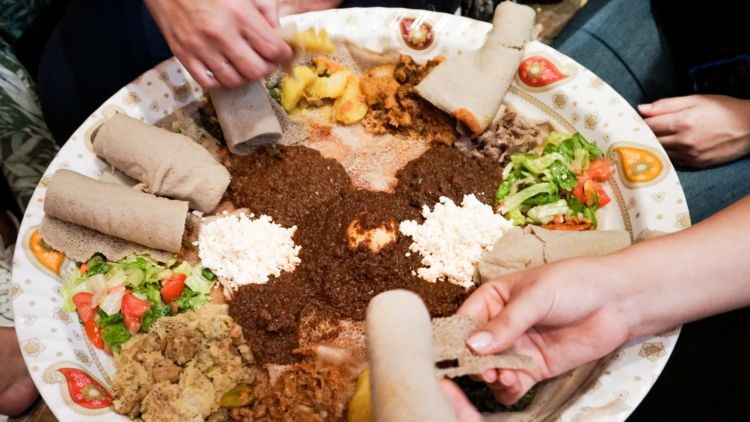
Stepping into Zagol in Karama is less like stepping into a restaurant, and more like stepping into an extension of an Ethiopian mother’s home. When you peek into the kitchen, you’ll see a flurry of activity as the ladies painstakingly prepare and plate up the platters of food. Rather than a regular dining table, Zagol serves its food over the traditional mesob and every platter arrives lined with spongy injera bread. This is not the sort of meal that can be enjoyed solo. Whether you order à la carte or go with one of their mixed platters, you need at least 3 to 4 other diners to sit around the platter, tear away pieces of injera (with the 3 fingers of your right hand) and use it to scoop up the different meat, vegetable and lentil dishes. And if you want to dial up the love for your fellow diners a notch, you can try gursha on them. Learn about this Ethiopian act of hospitality on our podcast or read about it in the transcript.
Given the extensive vegetarian feasting days in Ethiopia and that the injera bread is made from teff grain (gluten-free), Zagol is a solid bet for vegetarians and gluten-free diets.
Another notable Ethiopian favourite in the city is Habasha, which has multiple locations but our go-to spot is usually the Abu Hail branch.
6. SUDANESE FOUL AT FOUL ABU ABBAS
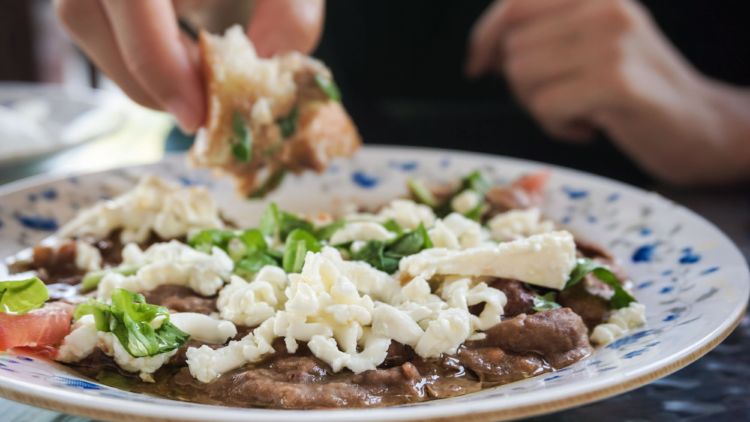
It might be brown and sludgy, but don’t let appearances dissuade you from tearing away your bread and dipping it deep into a pool of foul. Slow cooked fava beans are found all over the region, from Egypt to Lebanon, but the Sudanese do their own twist topped with threads of white cheese. Foul Abu Abbas is a corner restaurant so tiny, that the only place to sit is on tables out on the pavement. You’d fit right in if you skipped the cutlery and dunked chunks of white baguette straight into the bowl of Sudanese-style foul. Nahla describes this notion of using bread as your cutlery to dip into dishes as ‘taghmees’ on the podcast. We will also never leave without a round of sujuk sausages and spicy peanut dipping sauce (dakwa).
Not a fan of audio? Here’s the show transcript for you to read!
4 cultures that eat with their hands:
Arva: This show is brought to you by Dubai’s most gluttonous food tour company: Frying Pan Adventures, and you’re listening to ‘Deep Fried’.
Hey there, I’m your host Arva Ahmed and thanks for joining me on the show that’s inspired by flavors of the East. This podcast celebrates the old-world flavors that we as storytellers, content creators and food tour guides with Frying Pan Adventures have discovered in Dubai.
And some of those flavors just taste better when you eat them straight-up with your hands. So this episode is going to be all about celebrating four old-world cultures that we found in the city that eat with their hands, minimal cutlery needed. We’re going to get into the quirks and the perks of eating with hands, as well as the etiquette behind how to do it properly.
Now, I just want to put this out there that the first rule of eating with hands is washing them thoroughly, both before and after the meal, the same way that you do with cutlery. But we want to be sensitive to the global health situation right now and we know that some of these meals also involve a communal element, which may not make sense in scenarios beyond your immediate home and family, right now.
We ourselves have moved to a format with individual portions on our food tours right now. So, if you really wanted to practice eating with your heavily sanitized hands, it would be limited to your own plate. But we do miss those old school experiences and so, this episode is partly a throwback to that pre-COVID world and partly a hope for better times to come, you know, for the world to get back on its feet healthier and COVID-free so that we can dip into these communal meals together again.
Alright, so with that little disclaimer, joining me for this ‘No Cutlery’ conversation is our GM, food tour guide and fearless Indian warrior of spice, Farida Ahmed and the Jordanian-Bangladeshi artist, curator, food tour guide and home cook extraordinaire, Nahla Tabbaa.
Hey ladies, thanks for joining me!
Farida: Hi Arva. Hi Nahla. So good to be back doing this again!
Nahla: Hi, I’ve missed you!
Arva: Yeah, it’s been a while since we had the team doing an episode so it’s good to reconnect.
So let’s roll up our sleeves and dive into these cultures. So Farida, get us started. Which culinary culture are you going to be looking at?
Farida: So I’m going to be exploring the culinary cultures of India and interestingly the Philippines as well.
Arva: Alright, so take us to whichever place you want to take us to first, we’re game.
Farida: Okay but before that, in my usual style, I’m going to share an interesting factoid, because I just have to: did you both know that somewhere around the 11th century-or-so the church actually banned eating with forks? They considered it immoral.
Arva: Oh wow, I didn’t not expect that! No.
Farida: Yes! It was the courtesans of the day that would eat their sweets and desserts with the fork and that is why the church forbade all other people to use forks and declared them to be immoral.
So while knives and spoons have been around for millennia, the fork that we take for granted is a very recent entrant into our cutlery palette, if that’s what you were to call it.
Indian
But yes, coming back to India—Indians, we’ve always eaten with the hands, this is how we’ve grown up eating. I don’t think I really even knew how to use cutlery per se, until I was well into school. Now, this is not to say that we eat everything with hands. Obviously, things that are watery, for example, soups, you would eat with a spoon, you would serve yourself out of a common dish with a spoon as well.
But first things first, the basis of eating with hands, and very few Indians themselves know it today, traces back to Ayurveda. And Ayurveda that tells you that each of your five fingers is actually a conduit for the five elements of space, air, fire, water, earth. And when you eat with your hands, you actually activate the nerve endings of the tip of your fingers which make your digestive system more amenable to actually digesting the food as well.
So it’s a very, very healthy practice.
Arva: Can you walk us through some of the etiquette around how to eat with hands?
Farida: There are a few rules.
Number one, especially because we’re still in the environment of COVID. A lot of people tend to think that eating with hands is unsanitary—far from it.
The first rule with eating with your hands is: you have to wash your hands with soap, thoroughly, and back in the day in the noble houses, there would be a water bearer who would actually go around to all the people or the diners at the table with some water. And, you know, sometimes it would be perfumed as well and people would wash their hands right by the chair-side.
Second rule: never use your palm, you only use the tips or a little below tips of your fingers to sort of sweep up and scoop and pinch the food into a little mound or a morsel. If you’ve got bread, bread is a great vehicle, it works as a spoon, it works as a fork. That is what you would use to scoop up any, I want to say gravy-based dishes or even vegetable.
Once you form that little mound, you never bring the plate to your face. You would actually lower your head, bring your pinched fingers towards your mouth and without allowing your fingers to actually enter your mouth, you use your thumb as a kind of a little shovel and you push that little mound of food directly into your mouth. And then you go back for more.
Again, a lot of cultures licking your fingers is frowned upon. Luckily for me, I grew up in a home and in a family where it is not frowned upon, but we would usually reserve this satisfactory right till after you are done with the meal. Post-which again, you would wash your hands thoroughly with soap and water.
Arva: Yeah, I mean it sounds very complicated, the whole maneuvering process, but obviously if you’ve grown up doing it, it’s really simple and it just takes a little bit of practice and then you can kind of eject that bite into your mouth without having it fall all over the place, or even without getting more than your fingertips messy.
Farida: Yes, and you know what the best part is? You don’t have to worry about a dessert spoon, you don’t have to worry about a snail-fork, you don’t have to worry about a million knives and which way to go, in order, because your fingers—it’s the most natural thing. It’s the God-given, natural fork, if you were.
And again, coming back to Ayurveda, coming back to simple science, there are a lot of benefits when you eat with your hands. Increased blood circulation, for one. Also this actually helps you to maintain a more balanced weight, because when you eat with your hands you’re being more mindful. You can’t make big bites, so you actually take just enough food that will promote this feeling of satiety or even fullness.
And again, for any of those in love with yoga the way I am, unknowingly, when you scoop up your food, you’re actually—your hands are actually—forming a yogic mudra or a yogic pose which then connects all your five chakras and balances out, so you have a better flow of prana or life force as well.
Arva: Wow!
Farida: Yeah, interesting, right?
On a more practical note: your fingers will tell you how hot the food is. Now, you try doing that with a fork and knife and spoon, and yes, you can see the food steaming, but what about food that doesn’t give off steam?
So this is the best way to even warn yourself that: “Okay, you know what? You want to maybe wait a little bit.”
And finally, eating with your hands is a complete sensory experience because you bring in that critical element of touch .
Arva: Yeah, but you know what’s interesting is that folks who, like, I’ve met people who are not Indian and if they’re, for example, confronted with eating with their hands with bread that’s really simple—just tear away the bread and dip it in whatever else or use it to scoop up vegetables.
But when it’s the rice, that gets tricky and sometimes people assume that you can use the bread to scoop up the rice and then dip things in, but actually in India..
Farida: No..
Arva: ..bread and rice are different courses, they’re not had simultaneously.
Now what I have seen is in the North, typically, and of course, these are very broad, general statements, I think there are definitely nuances, but in general, what I’ve seen is in the North, people do eat their rice with a spoon..
Farida: Yes.
Arva: ..however, when you go to the South, that doesn’t happen. People kind of get into the rice, even if it gets sloppy. Like sometimes, you’re eating on a banana leaf and there’s a lot of liquid from the daal or whatever gravy that you’re adding in, but people are going to go in straight with their fingers and they know the technique of eating that rice directly with their hands without bread serving as the means to pick up the rice.
Farida: But it’s also a different grain of rice.
Sometimes in South India, it’s more traditional to use a shorter and thicker grain of rice, which actually absorbs the liquid far better than your usual slender basmati grain.
Nahla: True. Can I ask you a question though?
Farida: Yeah, of course.
Nahla: So mom growing up in a Bangladeshi household, was raised where it was frowned upon for them to, actually, eat with their hands. So they had to unlearn that from a very early age because it was considered unladylike, it was something that was reserved for not necessarily the upper class, but the lower class and I’m just wondering how, how that makes you feel and how as Indians you are tied to this idea of eating your hands as this like nationalism and resistance?
Farida: No. So, I don’t want you to give away your mum’s age but your mum is a post-independence baby, I’m assuming.
Nahla: Yes.
Farida: Actually, I know for sure. Which means her parents, your grandparents, were probably around the independence era and your great grandparents were pre-independence and this was a time when a lot of people from the Indian subcontinent were trying to mimic colonial customs and colonial customs changed.
Initially, when the British came to India, they would eat with their hands, but eventually, it was frowned upon—it was the thing that natives did. And I know this because one of my aunt’s, she grew up in a family where her father insisted that they adhere to British customs so that they would get more acceptance, you know, from a colonial perspective.
Nahla: Yes.
Farida: So, this is probably what happened with your mother’s family as well.
But for me personally, I did go through a stage, especially when I was away from college. I’d always been accustomed to eating my food with hands and I wasn’t..
Arva: Sorry you mean away from home?
Farida: ..away from home, sorry, away from home—when I went to college, away from home.
I was used to eating my food with my hands, I did know how to use cutlery, but I didn’t know all the nuances. And I had a really tough time because I would feel very awkward and sometimes I would just get up without feeling full because I didn’t know how to tackle a certain kind of food or I didn’t know how to tackle it with cutlery. And I would hesitate to tell people. I would keep looking over my shoulder to see who was looking at me.
And the only day I could eat with my hands was that one day of the year when we had cultural day. And I would wait for that because then suddenly it was okay to do so. But you know what now? I’m over it now. I don’t even think twice about it, I’m proud of it.
Nahla: Yeah.
Arva: But I think it’s a question of how you’re brought up and what you’re comfortable with. And I feel that there should be acceptance at all levels.
Farida: Absolutely.
Arva: I think for us growing up, Mum was very focused on teaching us how to eat neatly with our hands. So I remember she would always check our fingers to see how dirty they were after the meal, so that we could be taught how to eat very neatly.
And I know when I’ve shown guests how to eat with their hands-on tours they’ve always been so surprised that my fingers are so clean. And I say “Yeah, this is ‘cause mum spent a lot of time teaching us this.”
Or for example, at the end of the meal, she would say, something in Urdu, which is “Jannat kaa jharu,” like, you have to sweep the floor of heaven and make sure that there are no rice grains left on the plate. So you’re going with your fingers and you’re sort of sweeping up everything on the plate to make sure that there’s nothing left behind.
So there’s all of these little things and I’m sure that for families that are eating with cutlery they might have other things that are similar and really, it is about doing something that makes you feel most comfortable as well.
So let’s switch gears from India, Nahla, why don’t you take us into a culture that you know loves eating with hands?
Jordanian
Nahla: I will and I’ll take you to my own culture in the Middle East.
I’ll start with mansaf, and mansaf is the Jordanian national dish. This dish, by law, needs to be eaten with the hands. However, unlike what Farida said about, in India, not using the palm to scoop up the rice, to make into balls, this is literally what we do.
And I’ve demonstrated this on tour, where I show two versions of how rice and yoghurt and meat are eaten. And the look of our guest’s faces, when I would take, like, a fistful of rice and then just make this gesture of forming it in my palm, they’re just so shocked that this, like, delicate, little person just does this to their food, but this is exactly how it’s eaten. So you form these balls and then you scoop it into your mouth.
Now it’s not necessarily that we’ve all been taught to circle around this dish and have it with our hands. It is often something that’s reserved for male eaters. So they would be sort of circling around this dish and there are rules that apply as well.
So clean hands, you would need to use your right hand for this, you would almost need to make this tunnel, you kind of like abide by a territory, even within the plate, and of course, you would wash your hands straight after.
But any women who would join that, like feast, that huddle of men, would be considered the tomboy-ish one of us. So I had like one or two cousins who were legends and we would say it like, “Oh my God! There, she’s going to join the guys now.” Because it was not something that we were all taught to do.
But there’s no better way to enjoy mansaf than to eat it with the hands and accompany it with a diet coke, actually. Those are the two, like, best ways to have it.
Farida: ..to digest?
Nahla: Yeah.
Arva: Did not expect that. So, what, the ladies would eat separately in individual servings with a spoon and a fork or whatever else, or how did it work?
Nahla: Yeah, kind of. Yeah, I mean..now look, the idea of huddling and gathering around one dish, like, yes, in nomadic practices was the most practical thing to do.
Actually you would have this one big tray, people would be seated on the floor, but in this day and age, when you know, you have this big family gathering and you have this one platter on the dining table with everything else, it’s just not as practical anymore. So in nomadic settings, for example, you will find one or two platters spaced around and people are huddled around that.
Arva: And people are not shy about feeding other people in the sense of, if there’s a good cut of meat and I wanted to give it over to someone else, you would sort of just pluck it away with your hands and you would put it in front of the other person that you wanted to give. Right? I’ve seen this happen a lot.
Nahla: Agreed.
Arva: It’s a sign of love..
Nahla: It absolutely is..
Arva: ..even though I’m sure that someone who’s not grown up in that culture would be really shocked. Like, “What? You just touched it with your bare hands and you’ve put it in front of me!”
Nahla: Exactly, it’s happened so many times and the only thing you can do really is just welcome this gesture. It is like a big hug that’s been reserved for you, so yeah, you just graciously need to accept it and enjoy it.
Farida: You know but this happens in our home every day as well.
Nahla: Yeah. Yeah, yeah, absolutely. And Arva, I don’t know if you recall, you and I going to dinner one day at this couple’s home with your parents and a few of us were around the table..
Arva: Yes!
Nahla: ..and we were eating a very bony fish. It was, I can’t remember the name of the fish, but I was having a hard time with the bones and the lady of the house, she just took my fish and with her hands, just dissolved it for me.
Farida: Deboned it?
Nahla: She deboned it and then put it back on my plate. And honestly, that was the sweetest, most maternal gesture, I couldn’t help it, I was so happy. I was taken aback, but definitely happy that someone took the time to do that for me.
Arva: Yeah. And one more thing I want to add is, especially in the kind of communal, like, everyone eating from one plate situation, it’s not that you just grab at every part of the plate..
Farida: Oh, no, no, no.
Arva: ..you really stick to the triangle of food that is in front of you.
So, I don’t know about Jordan, but at least for us, when we do these kinds of communal meals, it would be considered pretty rude to reach over and go to the other side.
Farida: Yes.
Farida: Definitely.
Arva: ..we don’t do that. I mean, that’s why you have the host who, kind of, redistributes if there’s a good cut of meat that he wants the other guests to have. He will do that, that’s fine, but you don’t typically do a land-grab.
Nahla: Yes, yes definitely. And you know another beautiful thing is, when I was researching Sudanese eating habits, they typically eat with their hands as well, out of one plate, but they also drink out of the same cup as well. So everything is kind of shared on this one table.
And as I was doing my research I read that typically as conservative cultures as well, this is a really beautiful way for men and women to exchange intimacy with one another and kind of say what they want to say to each other, without saying too much. It’s the sharing of food and eating out of one plate that kind of establishes that bond. And I do find it extremely intimate and pretty romantic.
Arva: Wow! That’s really beautiful. Alright, well thank you for sharing that.
So I think there’s a ton of Indian restaurants where you can kind of go right in with your hands, but Farida, you mentioned, also, this practice of someone coming around to wash your hands.
I don’t know whether people are still doing that right now during COVID, but one place that I had enjoyed that in the past was at Maharajah Bhog, which is one of my favorite places for vegetarian Indian thaali.
Thaali is a concept where you get a whole bunch of, an assortment of different—in this case—vegetarian dishes and you eat most of them with your hands, with bread, and then rice comes in later.
But they come around, at the table, and they wash your hands at the table in the way that Farida described, so I think there are places in the city you can do that.
But Nahla, what about the mansaf situation?
Nahla: So mansaf is something we’ll end up ordering to the house, more than we’ll have it at a restaurant, mainly because it’s there for a family to enjoy together in the most rudimentary way. You don’t necessarily want to sit at a restaurant and abide by regular etiquette.
Arva: Alright, well we are going to continue digging through cultures that enjoy eating with their hands. But first, we are going to take a quick digestive break..
..and we are back to digging into this episode of Deep Fried with our beautiful, bare and very meticulously washed hands.
Alright, so Farida, take it away. What culture have you got for us next?
Filipino
Farida: The Philippines!
Now, I did not know this until I started researching a little bit more on this topic..
Nahla: Fun!
Farida: ..yes, Nahla, they actually have a word for eating with hands. They call it Kamayan, forgive my pronunciation, I hope it’s right.
And I was actually speaking to..
Arva: Kamayan, you said?
Farida: Kamayan—K A M A Y A N. And I was asking this friend of mine, her name is Rida, a little bit more about it and interestingly, she told me that when she was growing up, if you didn’t eat with your hands, like people or children who didn’t eat with the hands, they would look upon them as being snobbish or, you know, too big for their boots. So eating with your hands was considered a mark of being, you know, down to earth and I absolutely loved that, uh, snippet that she shared with me.
But with kamayan, there is again, a way to do it and there is etiquette. So first off, unlike the Middle East or the Indian Subcontinent. You are not bound to eating with your right hand only, so this is really great news for those who are left-handed. It is your dominant hand that you are allowed to eat with.
Arva: Oh!
Farida: Yeah, so if you’re left-handed, you are welcome to use your left hand.
In Indian and Middle Eastern cultures if you were to eat with your left hand you would be frowned upon.
So, luckily, the Philippines is a little bit more forgiving when it comes to that. They usually will, again, take a little bit of rice—and anything that is eaten along with rice is called ulam, U L A M, whether it’s a piece of meat, whether it’s some vegetables—so it’s rice and ulam that you would eat with your hands.
Again, you’d make a little mound and you’d place your ulam on top of that little mound of rice. So bite-sized portion of rice under it and you’d squeeze it all together. And again, you would take your hand to your mouth and use your thumb as a shovelling action to push that bite in. And that’s kamayan!
Arva: And where can we try kamayan in the city?
Farida: I would say any place that has a ‘Boodle Fight’.
Again, Dampa is a really popular place that you can try this at and another place that I love to go to again, another friend of mine, Hannah, introduced me to it: Off The Hook—great seafood, great way to experience this culture of eating, kamayan.
Arva: Boodle Fight! So for folks who don’t know what Boodle fight is, tell us what it is.
Farida: Ooh, this is fun, fun, fun!
They lay out this huge leaf, I’m thinking it’s a banana leaf and there is mounds of rice, there’s fish, there’s chicken, there’s meat, there’s vegetables and everyone just sits around, and again remember you have your part. And you just grab food, make it into these little bite-size morsels and keep shovelling it into your mouth until you are ready to burst at the seams.
That is a Boodle Fight.
Nahla: Gloves or no gloves?
Farida: I’ve tried it with gloves and honestly, after some time I kind of took them off because they tore anyway..
Nahla: You gave up, right?
Farida: ..you give up and I’ll tell you something, when you have, especially something like fish Nahla, even if it’s been filleted, you know, the pin bones, what better way to feel those than with your bare fingers?
So I prefer without gloves and I can always wash my hands and we’re drowning in sanitizer these days, so I’m good.
Nahla: True, true.
Arva: I don’t know whether it’s true or not but I heard it was something that folks in the army had come up with, this idea of boodle fight?
Farida: Yes.
Nahla: Yes.
Arva: Okay.
Alright, so fantastic, that was the Philippines, kamayan, boodle fight. Some really fun things to try if you want to roll up your sleeves and dig right in.
Nahla, take us over..where are you going to take us?
Ethiopian
Nahla: Well, speaking of COVID and this idea of huddling around one plate—Zagol, our, my favorite Ethiopian eatery in the city has been on my mind a lot.
Have they been okay? Are people still going and breaking bread, literally, on one plate?
So the way Ethiopian food works is this: you have the support system of this teff-flour, fermented pancake that holds these spoonfuls of different sauces and curries and stews. And the only way you can get to it is to rip pieces of the injera pancake and scoop those morsels into your mouth, again, using your right hand.
We have a word for this in Arabic called ‘Taghmees’ and taghmees is a beautiful word because it simply means the act of dipping bread into sauce and that, like, smooth meeting between both and then putting that in your mouth.
Taghmees, also in a sense means to dig deeper, to unpack, so it’s all kind of part of that same exploration.
Arva: Ah, love that.
Farida: That’s beautiful.
Nahla: ..yeah..and connotation.
Now, another really cute gesture, I mean, Arva’s only ever done this to me. I’ve not had the privilege of an Ethiopian lady doing this to me, but giving me a gursha. A gurshameans a mouthful or a bribe or a tip.
It’s origins come from a fable written by, and I really hope I pronounce this well, Ephrem Eshete, who wrote about this evil king in Ethiopia who would treat his citizens so badly that he would gather them in the middle of this arena, starve them, but make them watch these beautiful feasts.
And the only way they could eat these feasts was with a very long spoon. So he would allow them a long spoon, but if you’re holding a long spoon, you can’t technically then put it back in your mouth.
Well, so what these starved citizens did was they ended up feeding each other, instead. And so the moral of the story is that Ethiopian people can only survive if they feed one another and help one another out.
And so the gursha as a gesture is really that, it’s taking a morsel of food that’s quite generous, I have to say, and putting it in someone’s mouth as an act of hospitality
Arva: Yes.
Nahla: It usually takes place with an older person taking care of a younger person, for example, or the host or hostess welcoming their guests. And it is incredibly intimate and really shocking when it happens.
Yeah, I feel like Arva and I have this, like, I don’t know, this connection, because of it.
Arva: I have so many fantastic memories of gursha.
And just to clarify, so when you are picking up the injera, whether it’s for yourself or whether you are feeding someone else, you are doing it with only three fingers, you are not using all five fingers of your hand.
It’s three fingers and very similar to what Farida was saying, is you are not supposed to dirty your fingers. Your fingers should be relatively clean if you are obviously a seasoned veteran of eating with your hands, when it comes to the traditional Ethiopian mesob.
But the lady who actually, really, taught me how to do this, I have to give her a shout out—her name is Sara—she runs a chain of Ethiopian restaurants in the country called Habasha.
And I remember having taken a TV crew there once to film an Ethiopian meal. I forget where they were from, I think maybe they were from Australia and I had told her: “You know, you should really show them the true hospitality. You should show the host gursha.”
And Sara is not the kind of person who goes 50%, like, she’s in there 500% or not at all. So she began with this, like you said, a larger than life bite. The point of a gursha is it’s bigger than what you would normally feed yourself, cause you’re feeding somebody else. And the bite has to be so big it should fill the whole mouth from the front up to your tonsils, literally.
And she fed the host of the show while we were filming, she fed him, and the camera crew just erupted into laughter. And then what she proceeded to do was she started doing gursha to every single person on the team.
So everybody was in splits and every single time they would open their mouth to say no, or to laugh at someone else, they would immediately be shut up by another massive bite in their mouth. It was hilarious! Her goal was really, she was like, “I don’t really care about the cameras. My goal is to just feed all of you.”
And that was so generous, it was hilarious at the same time, but it’s so true to Ethiopian hospitality.
Farida: I love that.
I will say this, you know, I’ve always found eating with hands to be something, well, I don’t want to say it’s more fun, but it is definitely more interactive. And that’s when I, when I eat with my hands, I don’t take food all too seriously. I actually do enjoy it a lot more. For me personally, I love that feel, that touching of the food.
And I’ve also been told that in our cultures when a mother feeds her childlike you said Nahla, that’s a very intimate gesture, but also it deepens the pheromonal connection between mother and child as well.
Nahla: Aw..
Arva: Oh!
Farida: ..so that’s something that’s really, really sweet and touching. I’m so happy that my mother did this for Arva and I, and that we get to do it with my niece.
Nahla: My father definitely did it with us. He would always scoop bread into spreads like labneh or hummus and make these like airplane or helicopter gestures. My mom, I’m going to have a word with her after this show, tell her how, like, horrible she was.
Arva: <laughing>
Farida: <laughing>
Oh, I have a question for you: when you’re cooking how do you taste your food? Do you use your spoon or what do you do to taste what you are cooking?
Nahla: I use a spoon, I’m sorry..
Farida: Oh, no, don’t be sorry, So here’s an interesting thing again. ..
Nahla: ..I mean, especially if it’s hot.
Farida: ..yeah, no, this is something I learned from my mom. So I will go in there with a spoon but I’ll drizzle it onto the palm of my hands, a few drops and then I’ll lick it.
And you know what I’ve realized lately, why that really helps is because your palms have natural, friendly, flora or bacteria, but also your fingers, if you’ve ever taste them and you can taste them now, no judgment, they actually taste a little salty. So when you taste off your hand, you’re probably going to end up using lesser salt in the actual food, which is another really great thing.
Nahla: That’s incredible!
Farida: Yeah..
Arva: I never thought of that.
Nahla: Never, never thought of that.
Farida: ..because if I eat with my fingers, the natural salt or whatever is present in there, makes sure that I don’t use more salt in my actual cooking.
Nahla: Okay, I’m definitely going to practice this more.
Farida: Wash your hands, go lick your fingers and tell me if you taste black salt or pink salt or rock salt, I don’t know!
Nahla: I taste like Rose petals Farida.
Arva: Oh, wow!
Farida: Amazing, then you don’t have to buy any more of those!
Arva: Ladies this was so much fun. Thank you for joining us.
I, as you guys know, honestly, I love, love, love eating with hands. That is my natural mode of operation and on the tours, I’ve actually loved teaching our guests how to do this too.
Nahla: Yeah.
You know, like Arva back to that point, we have featured hand eating and pretty much every tour that we’ve ever had. And it has been incredible to see how different cultures respond and almost relax at the end of it. So it starts off being something that’s quite uncomfortable, but then by the end of it, it is literally the thing that dissolves all tensions.
Arva: ..except eating rice with hands that does create a lot of tension for people.
I remember, we did the second version of our Sufra: No Cutlery, Please tour, which is literally just ‘eat-everything-with-your-hands’. And the second time around, we featured rice as one of the dishes, and I could see that it made people distinctly uncomfortable.
So that might be a next-level dish to try if you don’t typically eat with hands. I wouldn’t recommend going with rice, go with simple stuff first and then maybe that’s the way to dial-up the adventure, but thank you so much again for joining us.
And to our dear listener, if you want to get out there and you want to get your hands delicious, then we have shared a list of places in the city, on our blog www.fryingpanadventures.com/blog, where you can go out and try eating with your hands.
You can also connect with us over social at Frying pan Adventures on Instagram and Facebook and @fryingpantours on Twitter. And if you are looking for Farida and Nahla over Instagram, you can find them at.. Farida?
Farida: I am @FaridaA on Instagram.
Arva: ..awesome and Nahla..?
Nahla: I’m @NahlaTabbaa on Instagram.
Arva: Great, and we will make sure to share that in our show notes as well.
And if you enjoyed this episode, we would be over the moon if you could rate, review and share the show with your friends.
And before we head off, here’s a quote that I’ve personally used on many a food tour, where I had to encourage guests to jump in with their hands. I’m not exactly sure who it’s by, I think it’s a quote that some people attribute to the first Prime Minister of India Jawaharlal Nehru and some other people say it was the Shah of Iran, but whoever it was, they were very wise in saying that:
“Eating with a fork and knife is like making love through an interpreter.”

Arva Ahmed is the co-founder of Frying Pan Adventures, Dubai’s first food tour company, and a celebrated food explorer known for uncovering Dubai’s hidden culinary gems. Her expertise in the city’s diverse food scene has been featured in prominent publications such as CNN, Khaleej Times, BBC Travel, The Sun, The Independent and countless more. She also hosts Ditch the Silver on YouTube. Through her immersive tours and storytelling, Arva brings Dubai’s rich flavors and vibrant cultures to life.

